A Literature Review on E-commerce and Supply Chain Management
VerifiedAdded on 2023/04/08
|31
|3687
|399
Literature Review
AI Summary
This document presents a literature review focusing on e-commerce and supply chain management, analyzing several journal papers. It examines the impact of IT adoption on SMEs' supply chains in South Africa, the benefits and limitations of e-commerce in the Indian context, and the effectiveness of e-commerce logistics in various regions. The review includes details on research methodologies, data analysis techniques, and critical evaluations of each study, highlighting both the strengths and limitations of the research. The student provides insights into how each study contributes to understanding the complexities of integrating e-commerce with supply chain management, with a focus on practical applications and future research directions. The document also follows a structured format, detailing research objectives, processes, validation criteria, and critical thinking aspects for each reviewed paper.
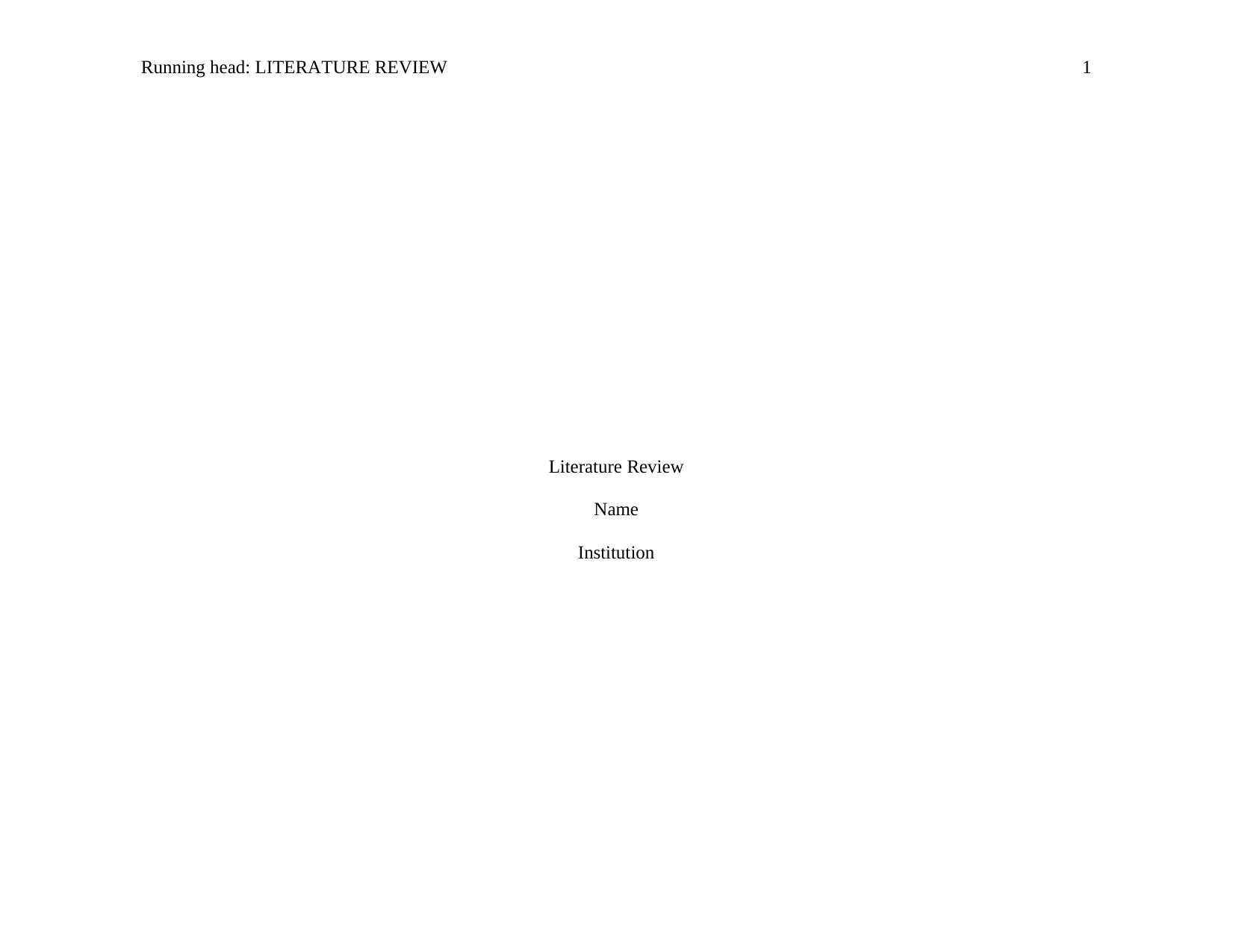
Running head: LITERATURE REVIEW 1
Literature Review
Name
Institution
Literature Review
Name
Institution
Paraphrase This Document
Need a fresh take? Get an instant paraphrase of this document with our AI Paraphraser
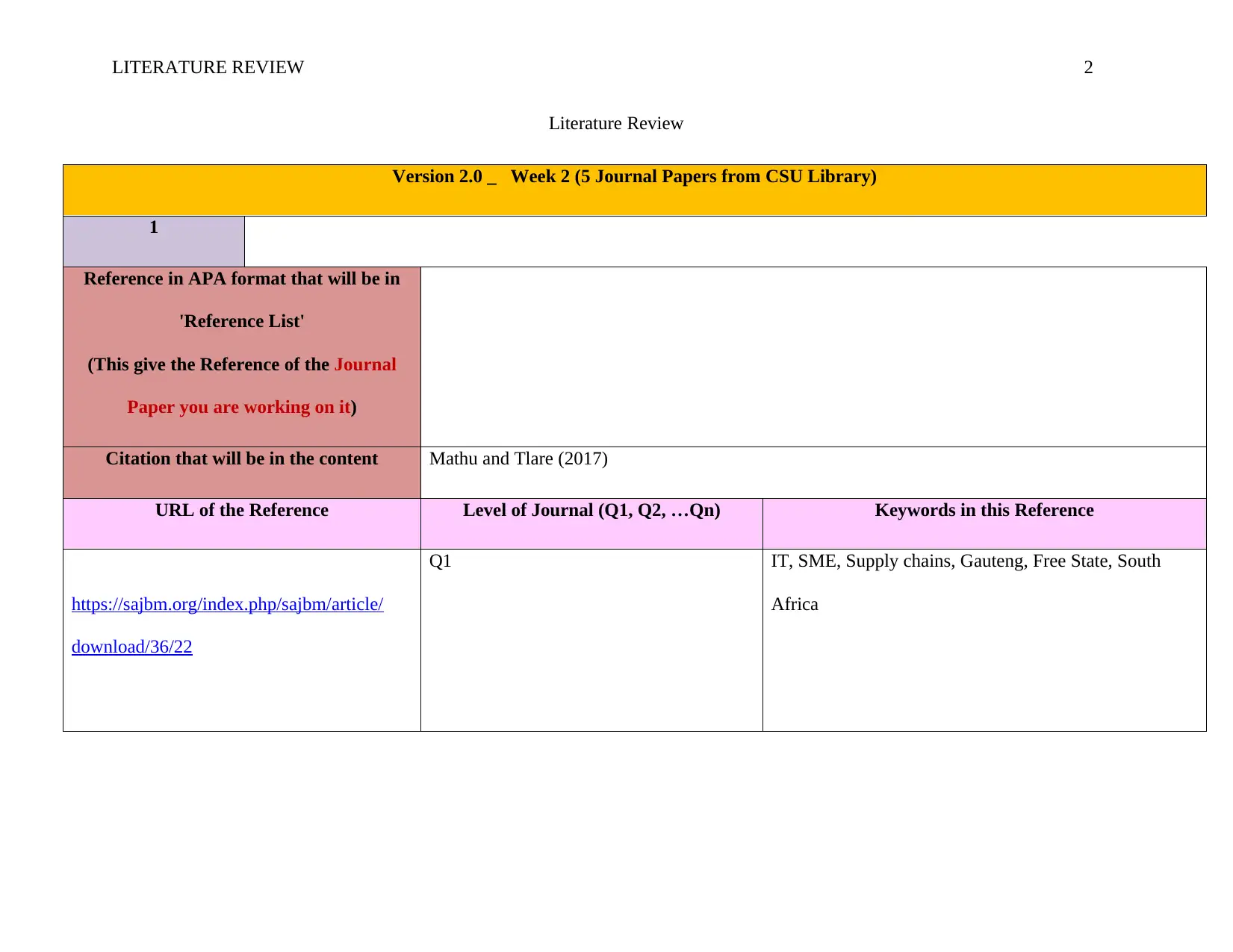
LITERATURE REVIEW 2
Literature Review
Version 2.0 _ Week 2 (5 Journal Papers from CSU Library)
1
Reference in APA format that will be in
'Reference List'
(This give the Reference of the Journal
Paper you are working on it)
Citation that will be in the content Mathu and Tlare (2017)
URL of the Reference Level of Journal (Q1, Q2, …Qn) Keywords in this Reference
https://sajbm.org/index.php/sajbm/article/
download/36/22
Q1 IT, SME, Supply chains, Gauteng, Free State, South
Africa
Literature Review
Version 2.0 _ Week 2 (5 Journal Papers from CSU Library)
1
Reference in APA format that will be in
'Reference List'
(This give the Reference of the Journal
Paper you are working on it)
Citation that will be in the content Mathu and Tlare (2017)
URL of the Reference Level of Journal (Q1, Q2, …Qn) Keywords in this Reference
https://sajbm.org/index.php/sajbm/article/
download/36/22
Q1 IT, SME, Supply chains, Gauteng, Free State, South
Africa
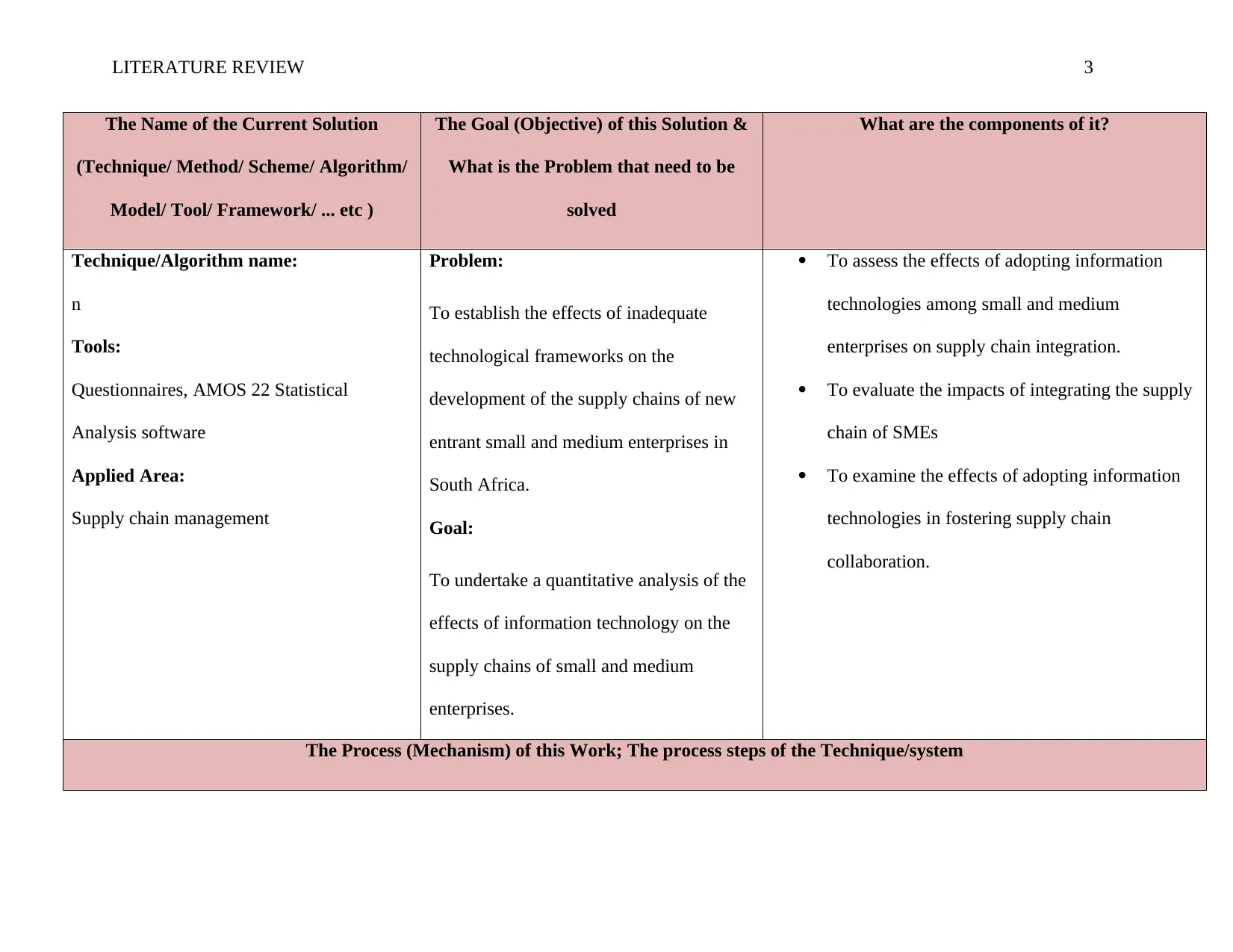
LITERATURE REVIEW 3
The Name of the Current Solution
(Technique/ Method/ Scheme/ Algorithm/
Model/ Tool/ Framework/ ... etc )
The Goal (Objective) of this Solution &
What is the Problem that need to be
solved
What are the components of it?
Technique/Algorithm name:
n
Tools:
Questionnaires, AMOS 22 Statistical
Analysis software
Applied Area:
Supply chain management
Problem:
To establish the effects of inadequate
technological frameworks on the
development of the supply chains of new
entrant small and medium enterprises in
South Africa.
Goal:
To undertake a quantitative analysis of the
effects of information technology on the
supply chains of small and medium
enterprises.
To assess the effects of adopting information
technologies among small and medium
enterprises on supply chain integration.
To evaluate the impacts of integrating the supply
chain of SMEs
To examine the effects of adopting information
technologies in fostering supply chain
collaboration.
The Process (Mechanism) of this Work; The process steps of the Technique/system
The Name of the Current Solution
(Technique/ Method/ Scheme/ Algorithm/
Model/ Tool/ Framework/ ... etc )
The Goal (Objective) of this Solution &
What is the Problem that need to be
solved
What are the components of it?
Technique/Algorithm name:
n
Tools:
Questionnaires, AMOS 22 Statistical
Analysis software
Applied Area:
Supply chain management
Problem:
To establish the effects of inadequate
technological frameworks on the
development of the supply chains of new
entrant small and medium enterprises in
South Africa.
Goal:
To undertake a quantitative analysis of the
effects of information technology on the
supply chains of small and medium
enterprises.
To assess the effects of adopting information
technologies among small and medium
enterprises on supply chain integration.
To evaluate the impacts of integrating the supply
chain of SMEs
To examine the effects of adopting information
technologies in fostering supply chain
collaboration.
The Process (Mechanism) of this Work; The process steps of the Technique/system
⊘ This is a preview!⊘
Do you want full access?
Subscribe today to unlock all pages.

Trusted by 1+ million students worldwide
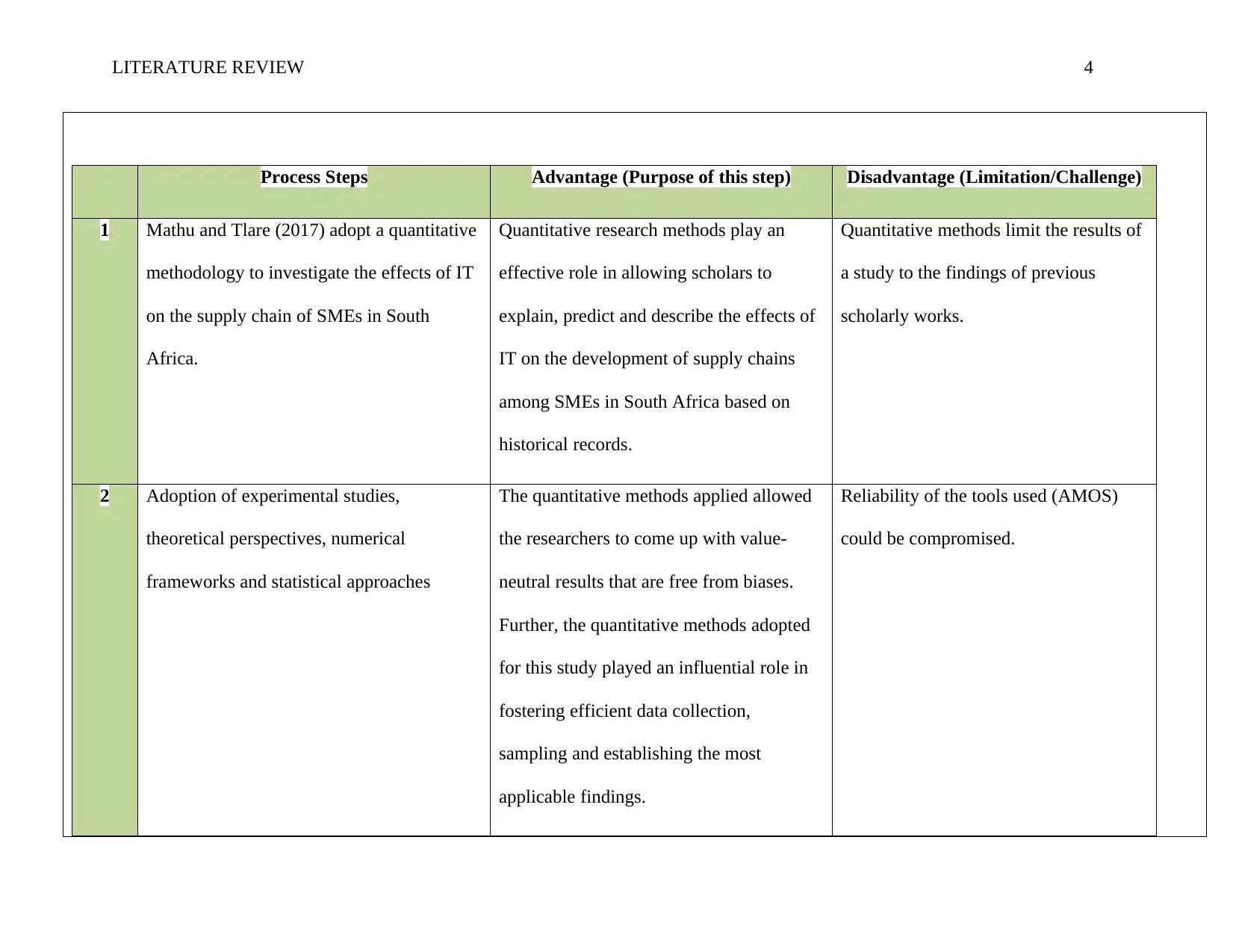
LITERATURE REVIEW 4
Process Steps Advantage (Purpose of this step) Disadvantage (Limitation/Challenge)
1 Mathu and Tlare (2017) adopt a quantitative
methodology to investigate the effects of IT
on the supply chain of SMEs in South
Africa.
Quantitative research methods play an
effective role in allowing scholars to
explain, predict and describe the effects of
IT on the development of supply chains
among SMEs in South Africa based on
historical records.
Quantitative methods limit the results of
a study to the findings of previous
scholarly works.
2 Adoption of experimental studies,
theoretical perspectives, numerical
frameworks and statistical approaches
The quantitative methods applied allowed
the researchers to come up with value-
neutral results that are free from biases.
Further, the quantitative methods adopted
for this study played an influential role in
fostering efficient data collection,
sampling and establishing the most
applicable findings.
Reliability of the tools used (AMOS)
could be compromised.
Process Steps Advantage (Purpose of this step) Disadvantage (Limitation/Challenge)
1 Mathu and Tlare (2017) adopt a quantitative
methodology to investigate the effects of IT
on the supply chain of SMEs in South
Africa.
Quantitative research methods play an
effective role in allowing scholars to
explain, predict and describe the effects of
IT on the development of supply chains
among SMEs in South Africa based on
historical records.
Quantitative methods limit the results of
a study to the findings of previous
scholarly works.
2 Adoption of experimental studies,
theoretical perspectives, numerical
frameworks and statistical approaches
The quantitative methods applied allowed
the researchers to come up with value-
neutral results that are free from biases.
Further, the quantitative methods adopted
for this study played an influential role in
fostering efficient data collection,
sampling and establishing the most
applicable findings.
Reliability of the tools used (AMOS)
could be compromised.
Paraphrase This Document
Need a fresh take? Get an instant paraphrase of this document with our AI Paraphraser
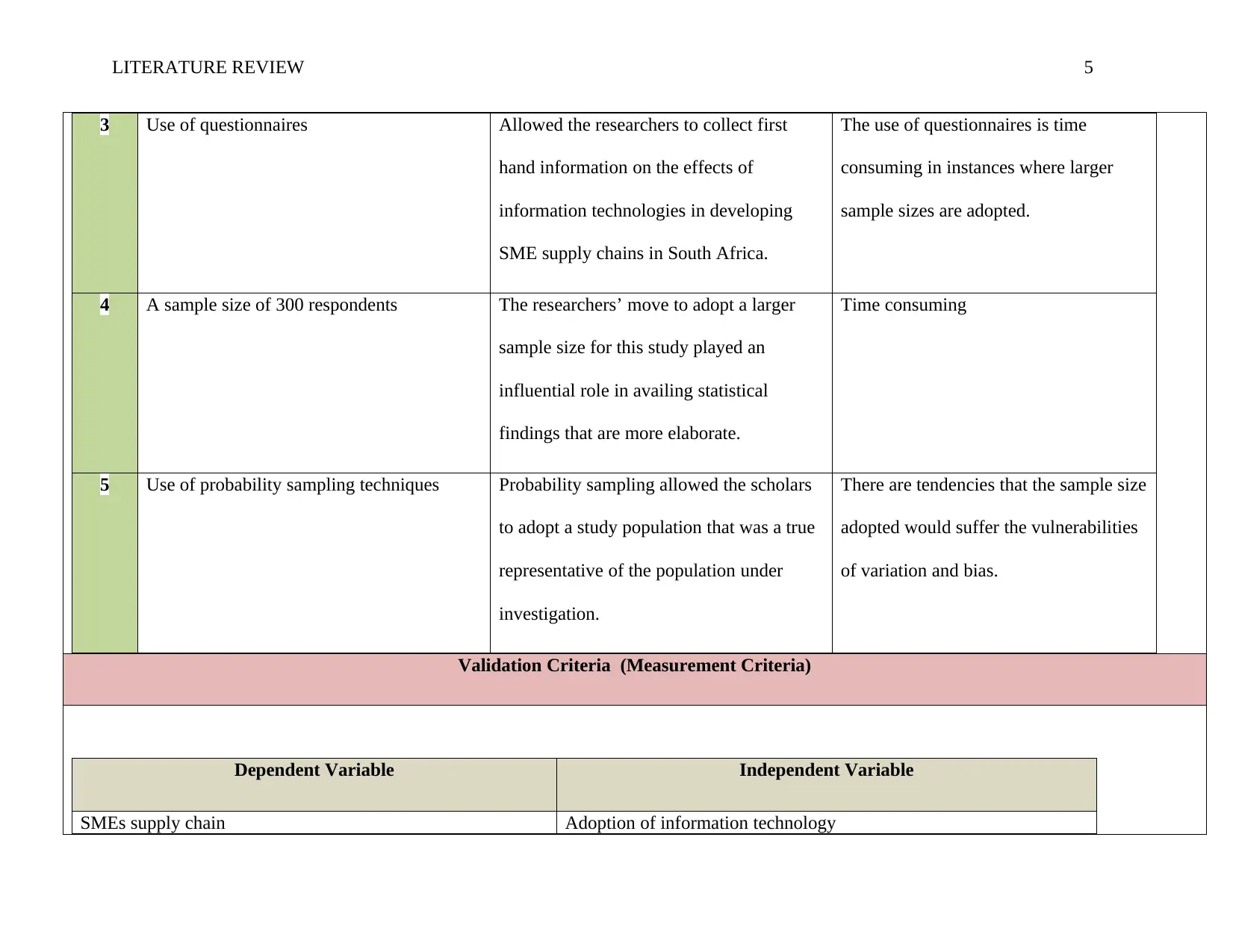
LITERATURE REVIEW 5
3 Use of questionnaires Allowed the researchers to collect first
hand information on the effects of
information technologies in developing
SME supply chains in South Africa.
The use of questionnaires is time
consuming in instances where larger
sample sizes are adopted.
4 A sample size of 300 respondents The researchers’ move to adopt a larger
sample size for this study played an
influential role in availing statistical
findings that are more elaborate.
Time consuming
5 Use of probability sampling techniques Probability sampling allowed the scholars
to adopt a study population that was a true
representative of the population under
investigation.
There are tendencies that the sample size
adopted would suffer the vulnerabilities
of variation and bias.
Validation Criteria (Measurement Criteria)
Dependent Variable Independent Variable
SMEs supply chain Adoption of information technology
3 Use of questionnaires Allowed the researchers to collect first
hand information on the effects of
information technologies in developing
SME supply chains in South Africa.
The use of questionnaires is time
consuming in instances where larger
sample sizes are adopted.
4 A sample size of 300 respondents The researchers’ move to adopt a larger
sample size for this study played an
influential role in availing statistical
findings that are more elaborate.
Time consuming
5 Use of probability sampling techniques Probability sampling allowed the scholars
to adopt a study population that was a true
representative of the population under
investigation.
There are tendencies that the sample size
adopted would suffer the vulnerabilities
of variation and bias.
Validation Criteria (Measurement Criteria)
Dependent Variable Independent Variable
SMEs supply chain Adoption of information technology
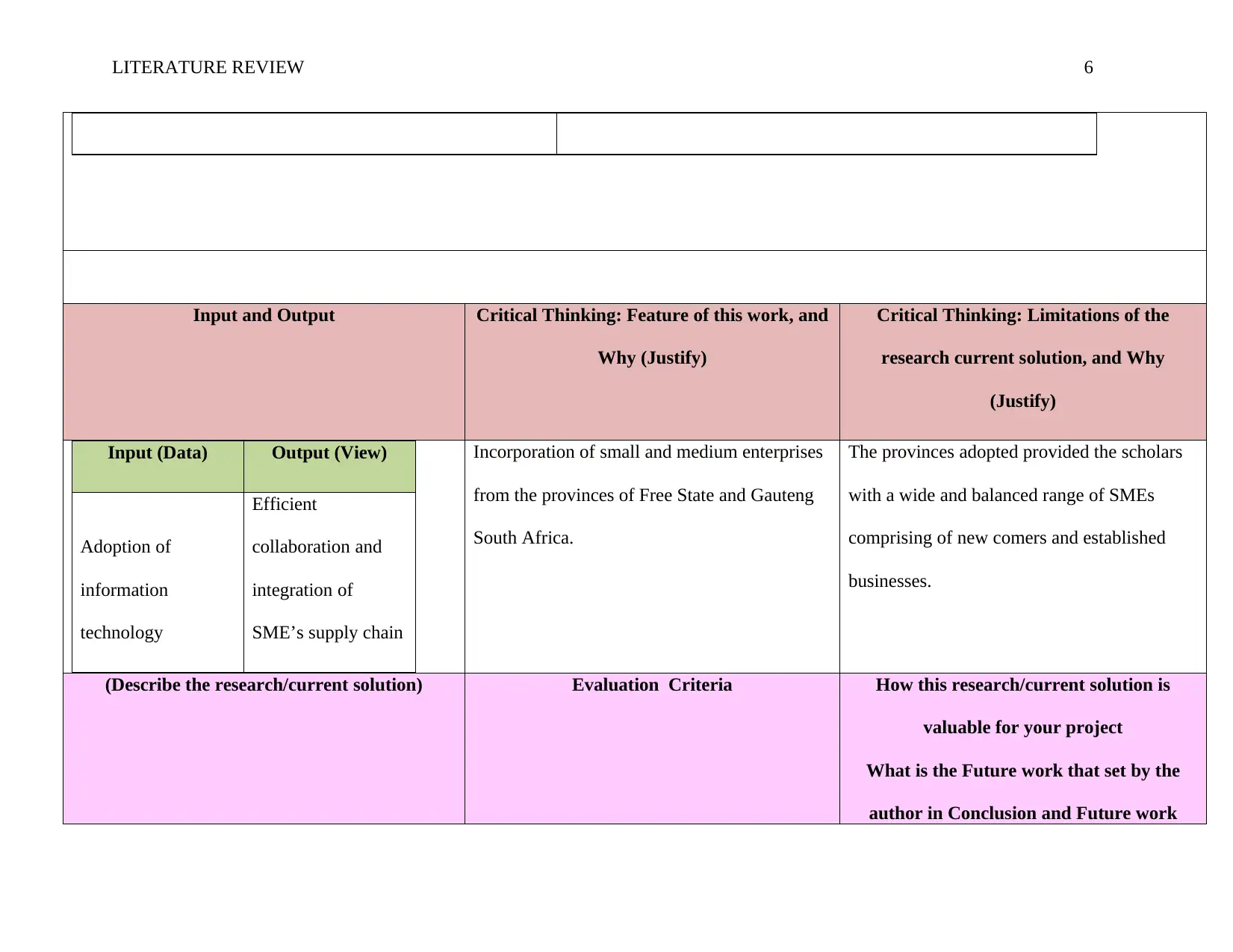
LITERATURE REVIEW 6
Input and Output Critical Thinking: Feature of this work, and
Why (Justify)
Critical Thinking: Limitations of the
research current solution, and Why
(Justify)
Input (Data) Output (View)
Adoption of
information
technology
Efficient
collaboration and
integration of
SME’s supply chain
Incorporation of small and medium enterprises
from the provinces of Free State and Gauteng
South Africa.
The provinces adopted provided the scholars
with a wide and balanced range of SMEs
comprising of new comers and established
businesses.
(Describe the research/current solution) Evaluation Criteria How this research/current solution is
valuable for your project
What is the Future work that set by the
author in Conclusion and Future work
Input and Output Critical Thinking: Feature of this work, and
Why (Justify)
Critical Thinking: Limitations of the
research current solution, and Why
(Justify)
Input (Data) Output (View)
Adoption of
information
technology
Efficient
collaboration and
integration of
SME’s supply chain
Incorporation of small and medium enterprises
from the provinces of Free State and Gauteng
South Africa.
The provinces adopted provided the scholars
with a wide and balanced range of SMEs
comprising of new comers and established
businesses.
(Describe the research/current solution) Evaluation Criteria How this research/current solution is
valuable for your project
What is the Future work that set by the
author in Conclusion and Future work
⊘ This is a preview!⊘
Do you want full access?
Subscribe today to unlock all pages.

Trusted by 1+ million students worldwide
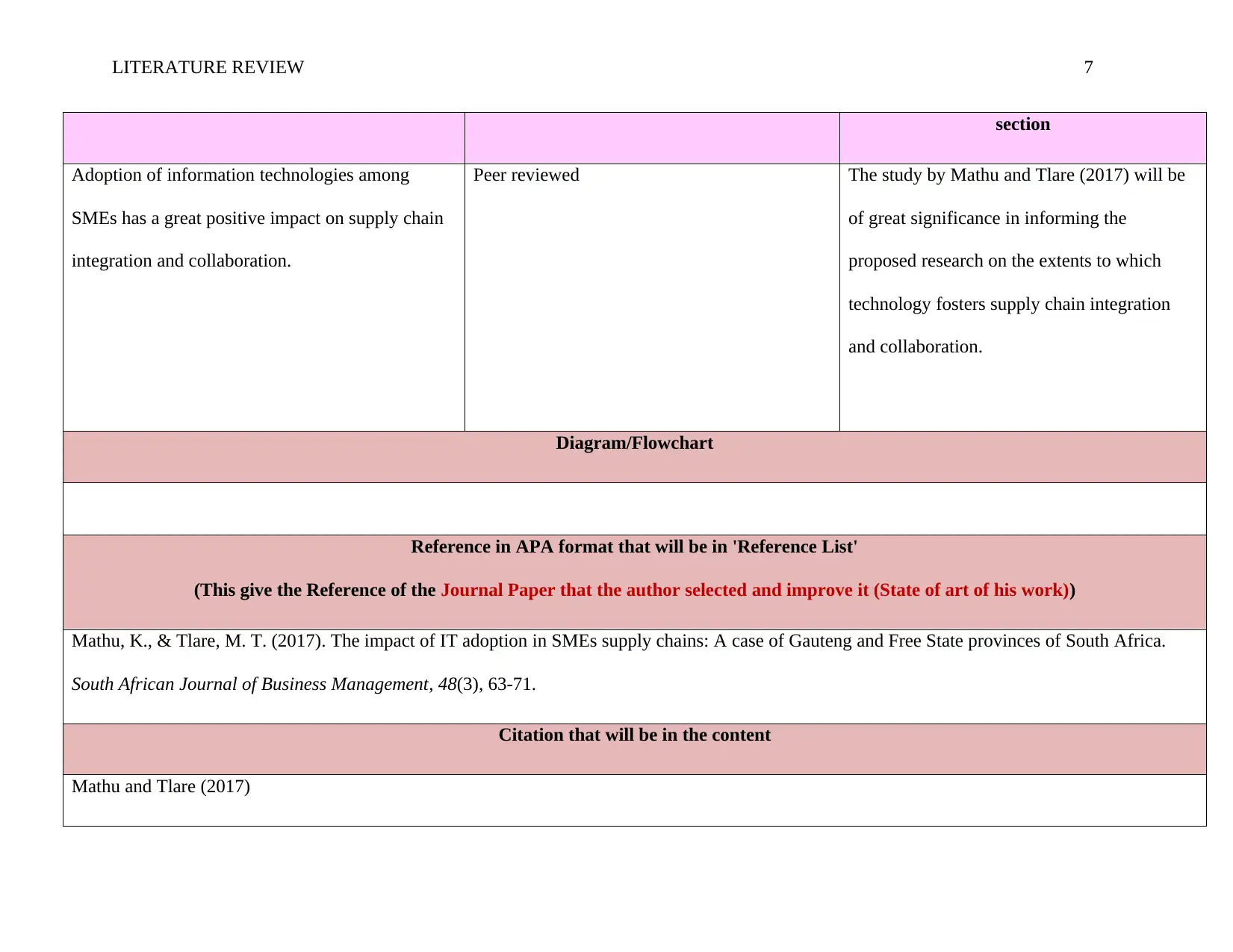
LITERATURE REVIEW 7
section
Adoption of information technologies among
SMEs has a great positive impact on supply chain
integration and collaboration.
Peer reviewed The study by Mathu and Tlare (2017) will be
of great significance in informing the
proposed research on the extents to which
technology fosters supply chain integration
and collaboration.
Diagram/Flowchart
Reference in APA format that will be in 'Reference List'
(This give the Reference of the Journal Paper that the author selected and improve it (State of art of his work))
Mathu, K., & Tlare, M. T. (2017). The impact of IT adoption in SMEs supply chains: A case of Gauteng and Free State provinces of South Africa.
South African Journal of Business Management, 48(3), 63-71.
Citation that will be in the content
Mathu and Tlare (2017)
section
Adoption of information technologies among
SMEs has a great positive impact on supply chain
integration and collaboration.
Peer reviewed The study by Mathu and Tlare (2017) will be
of great significance in informing the
proposed research on the extents to which
technology fosters supply chain integration
and collaboration.
Diagram/Flowchart
Reference in APA format that will be in 'Reference List'
(This give the Reference of the Journal Paper that the author selected and improve it (State of art of his work))
Mathu, K., & Tlare, M. T. (2017). The impact of IT adoption in SMEs supply chains: A case of Gauteng and Free State provinces of South Africa.
South African Journal of Business Management, 48(3), 63-71.
Citation that will be in the content
Mathu and Tlare (2017)
Paraphrase This Document
Need a fresh take? Get an instant paraphrase of this document with our AI Paraphraser
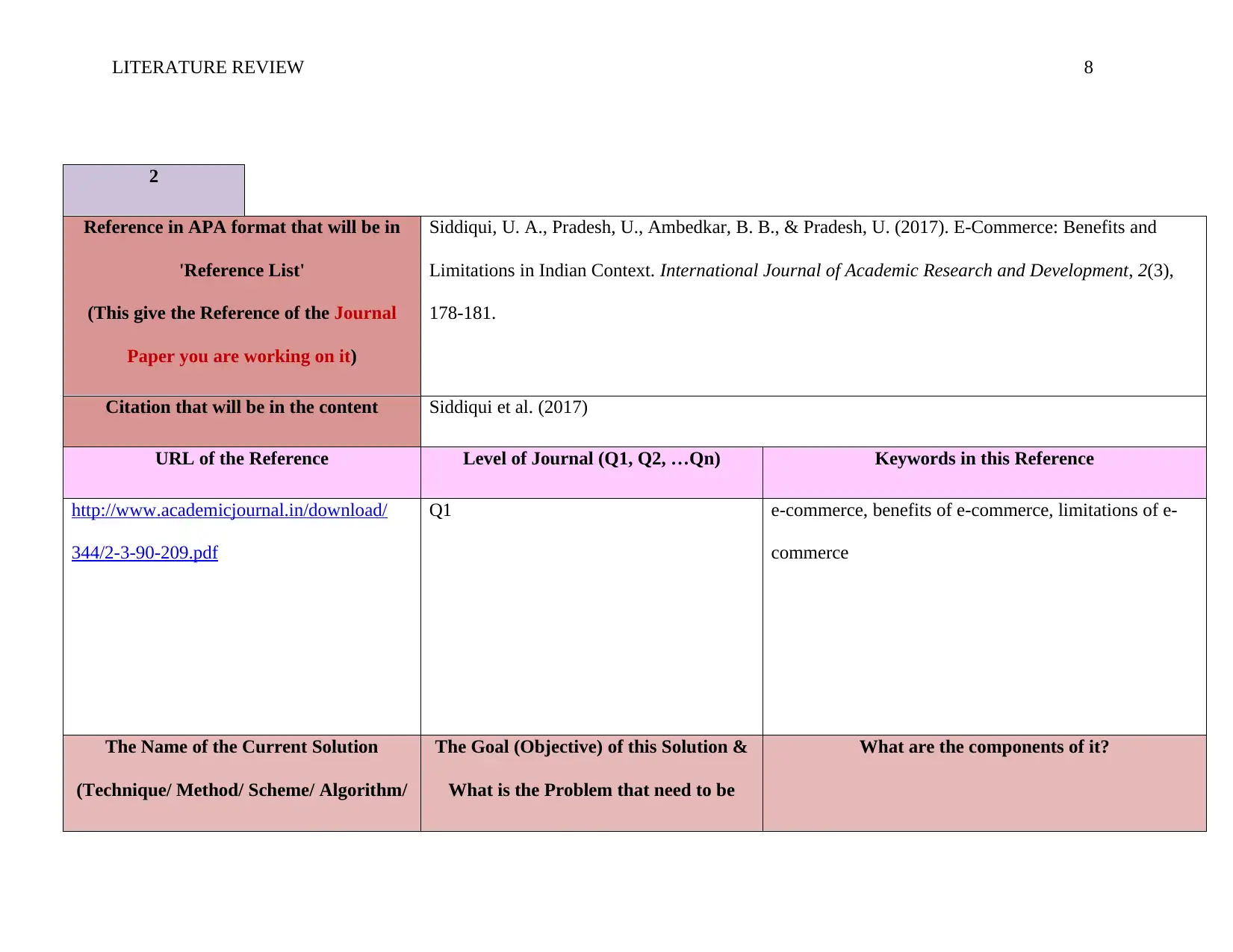
LITERATURE REVIEW 8
2
Reference in APA format that will be in
'Reference List'
(This give the Reference of the Journal
Paper you are working on it)
Siddiqui, U. A., Pradesh, U., Ambedkar, B. B., & Pradesh, U. (2017). E-Commerce: Benefits and
Limitations in Indian Context. International Journal of Academic Research and Development, 2(3),
178-181.
Citation that will be in the content Siddiqui et al. (2017)
URL of the Reference Level of Journal (Q1, Q2, …Qn) Keywords in this Reference
http://www.academicjournal.in/download/
344/2-3-90-209.pdf
Q1 e-commerce, benefits of e-commerce, limitations of e-
commerce
The Name of the Current Solution
(Technique/ Method/ Scheme/ Algorithm/
The Goal (Objective) of this Solution &
What is the Problem that need to be
What are the components of it?
2
Reference in APA format that will be in
'Reference List'
(This give the Reference of the Journal
Paper you are working on it)
Siddiqui, U. A., Pradesh, U., Ambedkar, B. B., & Pradesh, U. (2017). E-Commerce: Benefits and
Limitations in Indian Context. International Journal of Academic Research and Development, 2(3),
178-181.
Citation that will be in the content Siddiqui et al. (2017)
URL of the Reference Level of Journal (Q1, Q2, …Qn) Keywords in this Reference
http://www.academicjournal.in/download/
344/2-3-90-209.pdf
Q1 e-commerce, benefits of e-commerce, limitations of e-
commerce
The Name of the Current Solution
(Technique/ Method/ Scheme/ Algorithm/
The Goal (Objective) of this Solution &
What is the Problem that need to be
What are the components of it?
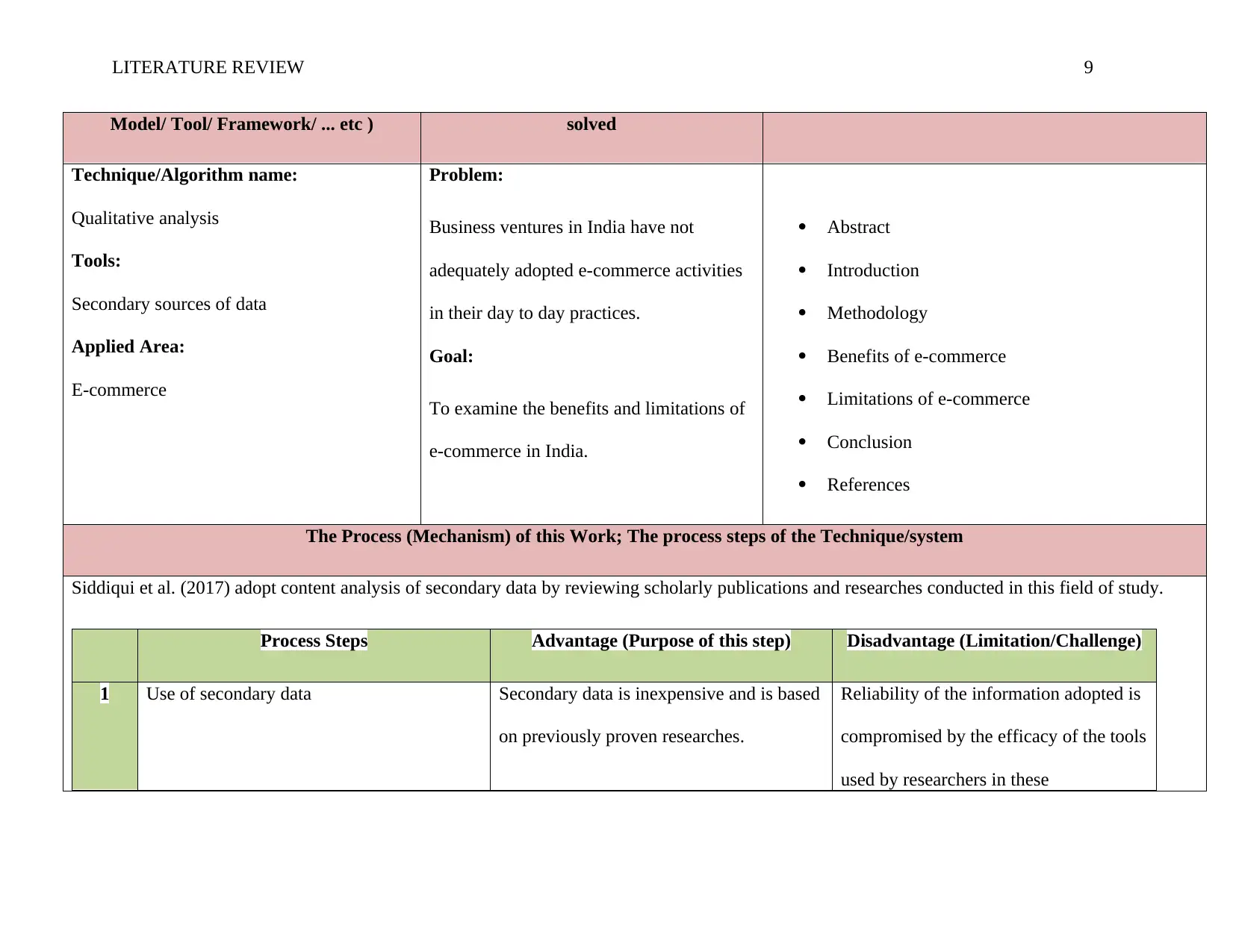
LITERATURE REVIEW 9
Model/ Tool/ Framework/ ... etc ) solved
Technique/Algorithm name:
Qualitative analysis
Tools:
Secondary sources of data
Applied Area:
E-commerce
Problem:
Business ventures in India have not
adequately adopted e-commerce activities
in their day to day practices.
Goal:
To examine the benefits and limitations of
e-commerce in India.
Abstract
Introduction
Methodology
Benefits of e-commerce
Limitations of e-commerce
Conclusion
References
The Process (Mechanism) of this Work; The process steps of the Technique/system
Siddiqui et al. (2017) adopt content analysis of secondary data by reviewing scholarly publications and researches conducted in this field of study.
Process Steps Advantage (Purpose of this step) Disadvantage (Limitation/Challenge)
1 Use of secondary data Secondary data is inexpensive and is based
on previously proven researches.
Reliability of the information adopted is
compromised by the efficacy of the tools
used by researchers in these
Model/ Tool/ Framework/ ... etc ) solved
Technique/Algorithm name:
Qualitative analysis
Tools:
Secondary sources of data
Applied Area:
E-commerce
Problem:
Business ventures in India have not
adequately adopted e-commerce activities
in their day to day practices.
Goal:
To examine the benefits and limitations of
e-commerce in India.
Abstract
Introduction
Methodology
Benefits of e-commerce
Limitations of e-commerce
Conclusion
References
The Process (Mechanism) of this Work; The process steps of the Technique/system
Siddiqui et al. (2017) adopt content analysis of secondary data by reviewing scholarly publications and researches conducted in this field of study.
Process Steps Advantage (Purpose of this step) Disadvantage (Limitation/Challenge)
1 Use of secondary data Secondary data is inexpensive and is based
on previously proven researches.
Reliability of the information adopted is
compromised by the efficacy of the tools
used by researchers in these
⊘ This is a preview!⊘
Do you want full access?
Subscribe today to unlock all pages.

Trusted by 1+ million students worldwide
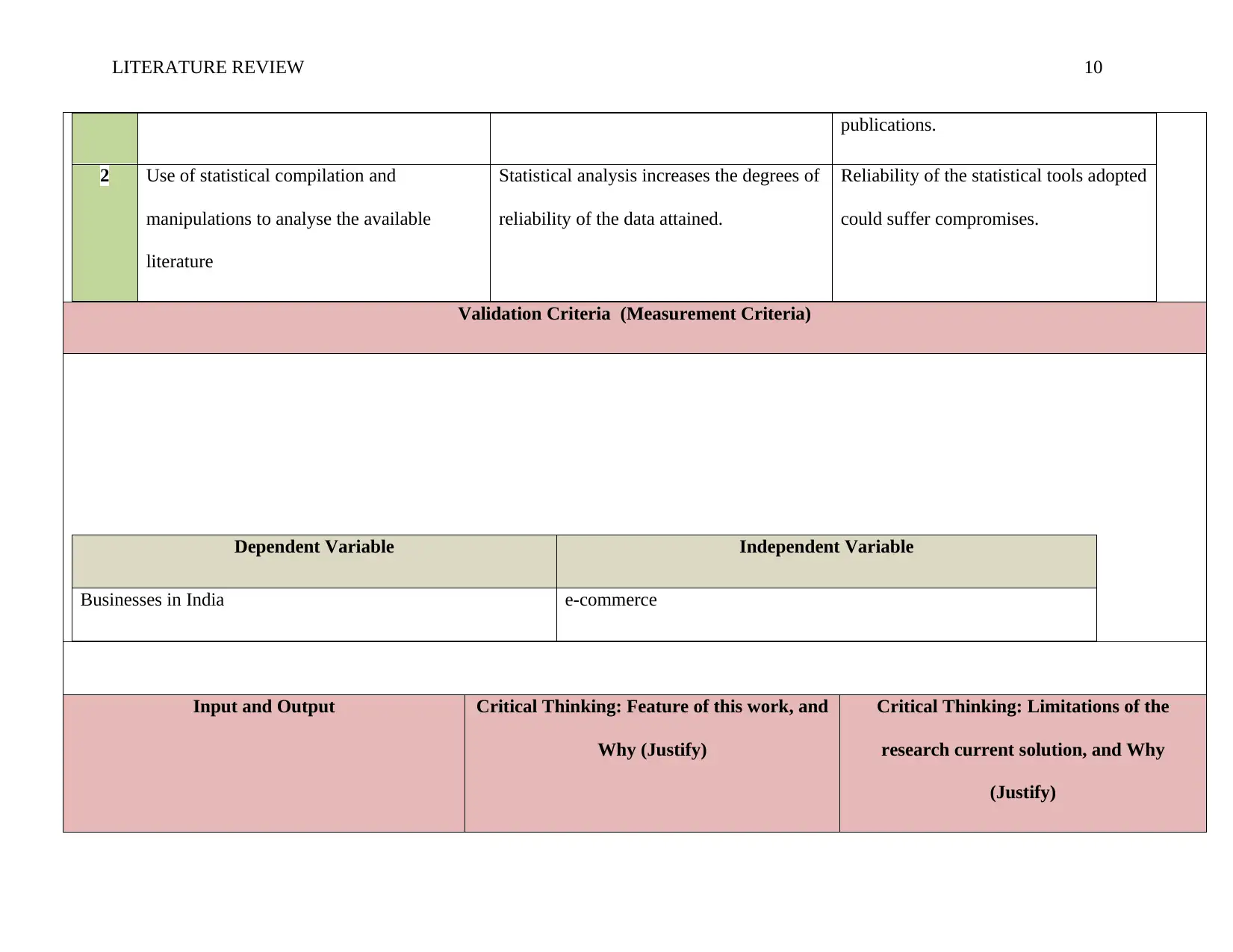
LITERATURE REVIEW 10
publications.
2 Use of statistical compilation and
manipulations to analyse the available
literature
Statistical analysis increases the degrees of
reliability of the data attained.
Reliability of the statistical tools adopted
could suffer compromises.
Validation Criteria (Measurement Criteria)
Dependent Variable Independent Variable
Businesses in India e-commerce
Input and Output Critical Thinking: Feature of this work, and
Why (Justify)
Critical Thinking: Limitations of the
research current solution, and Why
(Justify)
publications.
2 Use of statistical compilation and
manipulations to analyse the available
literature
Statistical analysis increases the degrees of
reliability of the data attained.
Reliability of the statistical tools adopted
could suffer compromises.
Validation Criteria (Measurement Criteria)
Dependent Variable Independent Variable
Businesses in India e-commerce
Input and Output Critical Thinking: Feature of this work, and
Why (Justify)
Critical Thinking: Limitations of the
research current solution, and Why
(Justify)
Paraphrase This Document
Need a fresh take? Get an instant paraphrase of this document with our AI Paraphraser
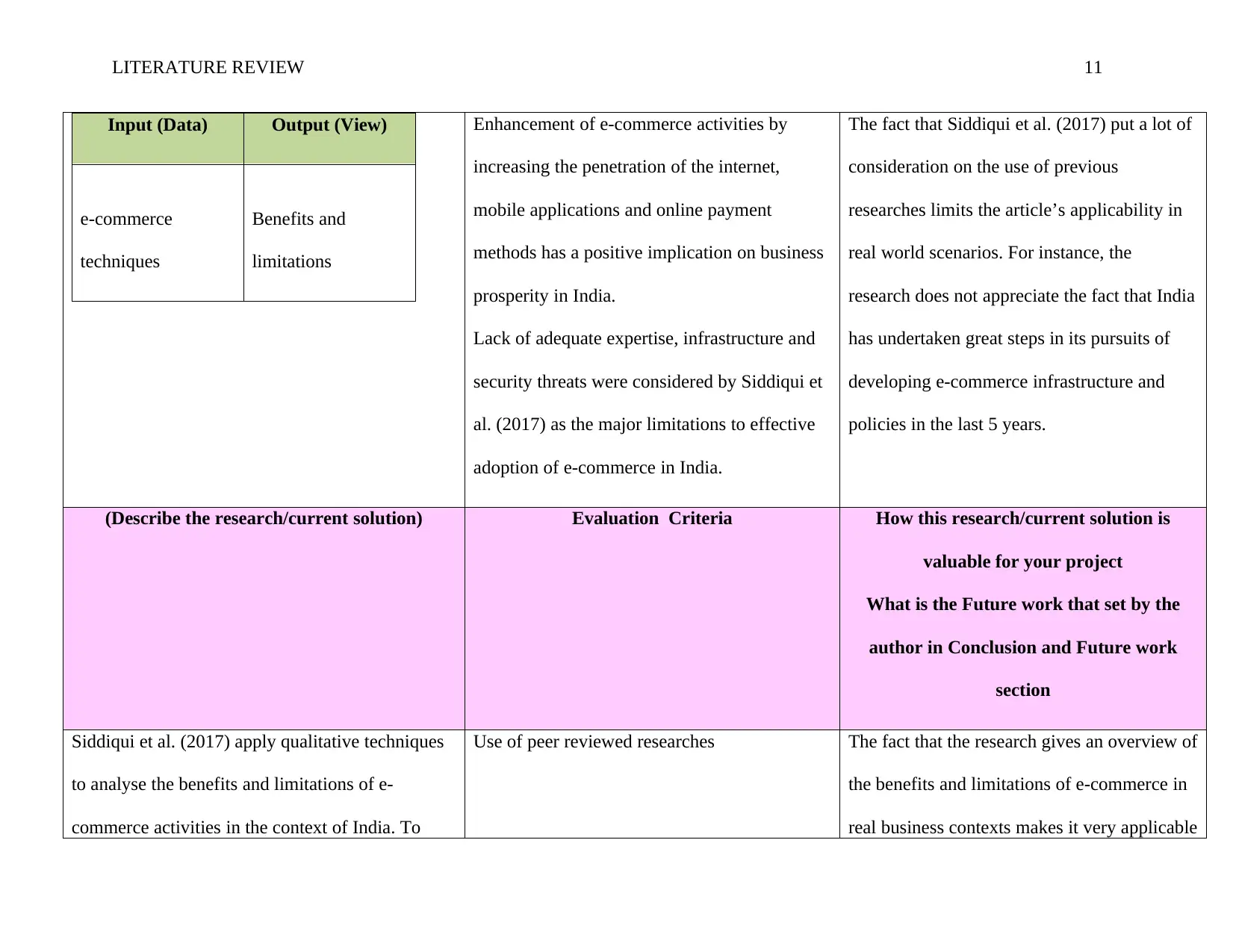
LITERATURE REVIEW 11
Input (Data) Output (View)
e-commerce
techniques
Benefits and
limitations
Enhancement of e-commerce activities by
increasing the penetration of the internet,
mobile applications and online payment
methods has a positive implication on business
prosperity in India.
Lack of adequate expertise, infrastructure and
security threats were considered by Siddiqui et
al. (2017) as the major limitations to effective
adoption of e-commerce in India.
The fact that Siddiqui et al. (2017) put a lot of
consideration on the use of previous
researches limits the article’s applicability in
real world scenarios. For instance, the
research does not appreciate the fact that India
has undertaken great steps in its pursuits of
developing e-commerce infrastructure and
policies in the last 5 years.
(Describe the research/current solution) Evaluation Criteria How this research/current solution is
valuable for your project
What is the Future work that set by the
author in Conclusion and Future work
section
Siddiqui et al. (2017) apply qualitative techniques
to analyse the benefits and limitations of e-
commerce activities in the context of India. To
Use of peer reviewed researches The fact that the research gives an overview of
the benefits and limitations of e-commerce in
real business contexts makes it very applicable
Input (Data) Output (View)
e-commerce
techniques
Benefits and
limitations
Enhancement of e-commerce activities by
increasing the penetration of the internet,
mobile applications and online payment
methods has a positive implication on business
prosperity in India.
Lack of adequate expertise, infrastructure and
security threats were considered by Siddiqui et
al. (2017) as the major limitations to effective
adoption of e-commerce in India.
The fact that Siddiqui et al. (2017) put a lot of
consideration on the use of previous
researches limits the article’s applicability in
real world scenarios. For instance, the
research does not appreciate the fact that India
has undertaken great steps in its pursuits of
developing e-commerce infrastructure and
policies in the last 5 years.
(Describe the research/current solution) Evaluation Criteria How this research/current solution is
valuable for your project
What is the Future work that set by the
author in Conclusion and Future work
section
Siddiqui et al. (2017) apply qualitative techniques
to analyse the benefits and limitations of e-
commerce activities in the context of India. To
Use of peer reviewed researches The fact that the research gives an overview of
the benefits and limitations of e-commerce in
real business contexts makes it very applicable
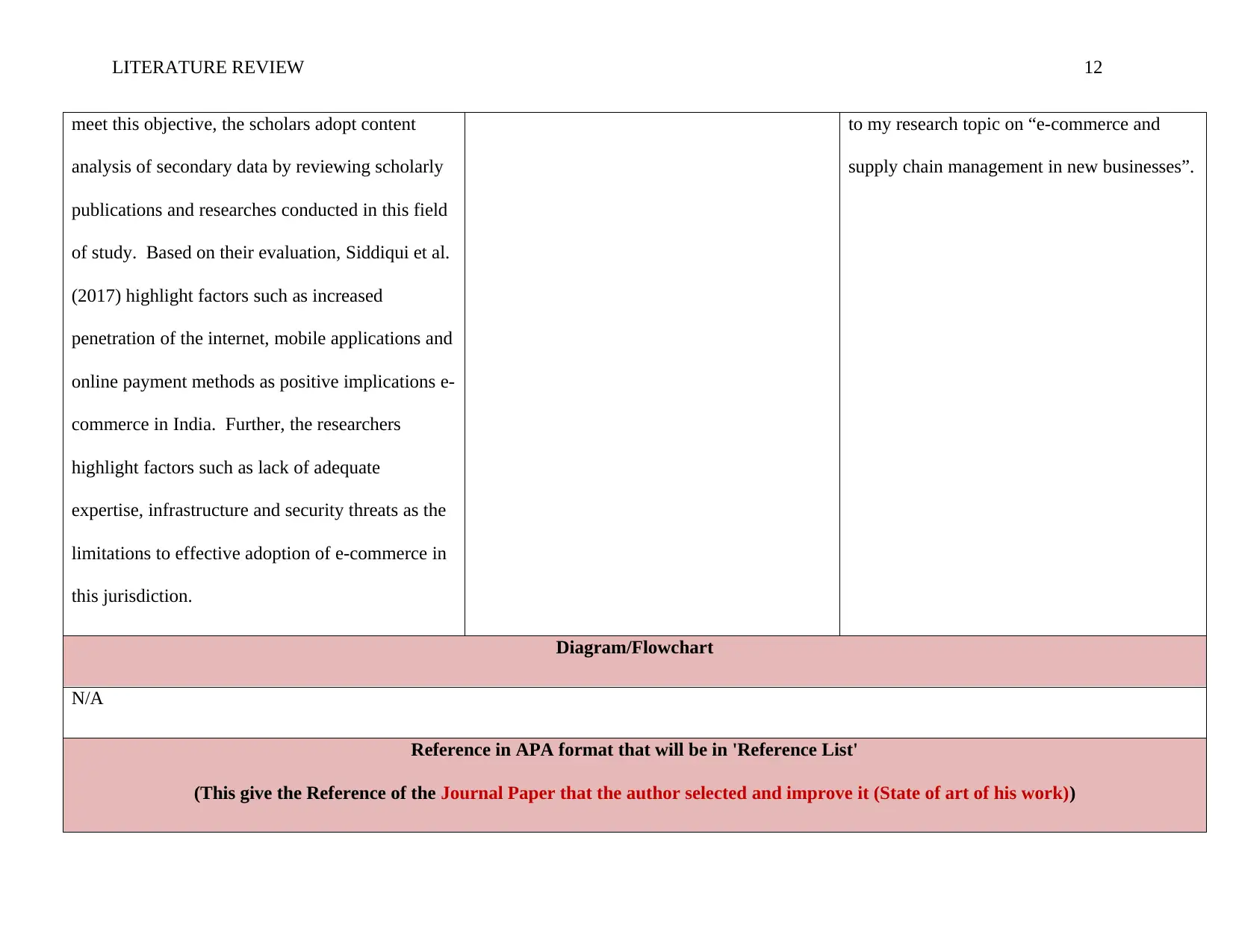
LITERATURE REVIEW 12
meet this objective, the scholars adopt content
analysis of secondary data by reviewing scholarly
publications and researches conducted in this field
of study. Based on their evaluation, Siddiqui et al.
(2017) highlight factors such as increased
penetration of the internet, mobile applications and
online payment methods as positive implications e-
commerce in India. Further, the researchers
highlight factors such as lack of adequate
expertise, infrastructure and security threats as the
limitations to effective adoption of e-commerce in
this jurisdiction.
to my research topic on “e-commerce and
supply chain management in new businesses”.
Diagram/Flowchart
N/A
Reference in APA format that will be in 'Reference List'
(This give the Reference of the Journal Paper that the author selected and improve it (State of art of his work))
meet this objective, the scholars adopt content
analysis of secondary data by reviewing scholarly
publications and researches conducted in this field
of study. Based on their evaluation, Siddiqui et al.
(2017) highlight factors such as increased
penetration of the internet, mobile applications and
online payment methods as positive implications e-
commerce in India. Further, the researchers
highlight factors such as lack of adequate
expertise, infrastructure and security threats as the
limitations to effective adoption of e-commerce in
this jurisdiction.
to my research topic on “e-commerce and
supply chain management in new businesses”.
Diagram/Flowchart
N/A
Reference in APA format that will be in 'Reference List'
(This give the Reference of the Journal Paper that the author selected and improve it (State of art of his work))
⊘ This is a preview!⊘
Do you want full access?
Subscribe today to unlock all pages.

Trusted by 1+ million students worldwide
1 out of 31
Related Documents
Your All-in-One AI-Powered Toolkit for Academic Success.
+13062052269
info@desklib.com
Available 24*7 on WhatsApp / Email
![[object Object]](/_next/static/media/star-bottom.7253800d.svg)
Unlock your academic potential
Copyright © 2020–2025 A2Z Services. All Rights Reserved. Developed and managed by ZUCOL.





